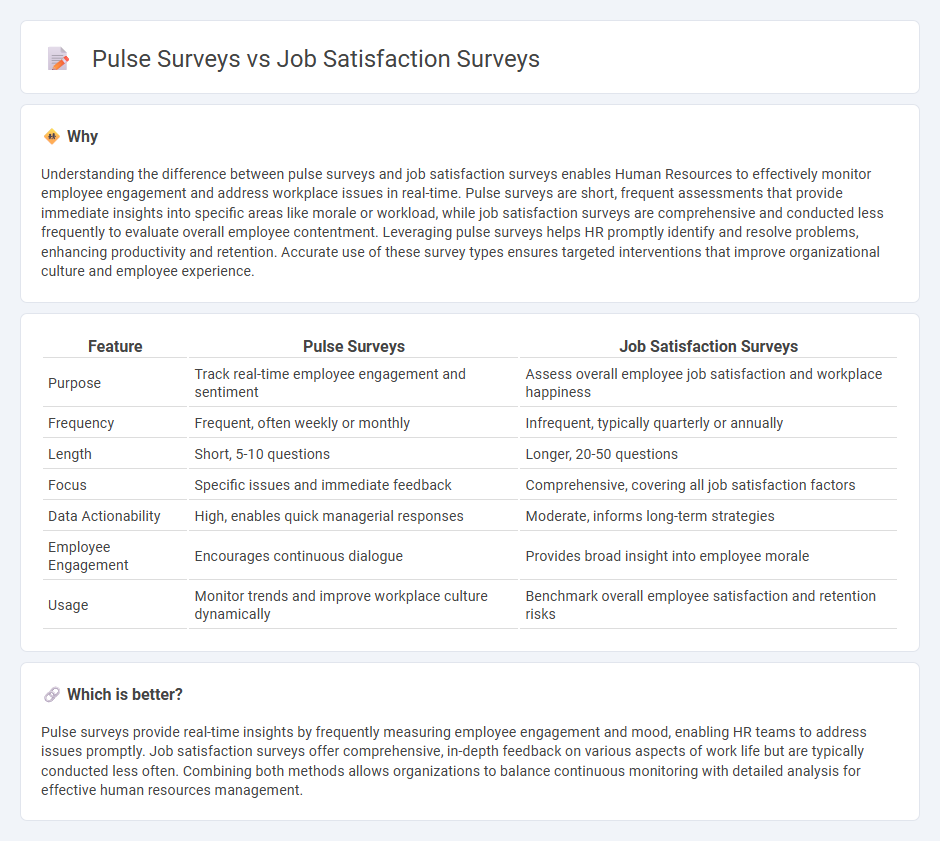
Pulse surveys offer frequent, brief check-ins that capture real-time employee sentiment and engagement levels, enabling HR teams to address issues promptly. Job satisfaction surveys provide a comprehensive analysis of factors influencing overall employee happiness and retention, often conducted less frequently for in-depth insights. Discover how integrating both approaches can enhance workforce management and organizational well-being.
Why it is important
Understanding the difference between pulse surveys and job satisfaction surveys enables Human Resources to effectively monitor employee engagement and address workplace issues in real-time. Pulse surveys are short, frequent assessments that provide immediate insights into specific areas like morale or workload, while job satisfaction surveys are comprehensive and conducted less frequently to evaluate overall employee contentment. Leveraging pulse surveys helps HR promptly identify and resolve problems, enhancing productivity and retention. Accurate use of these survey types ensures targeted interventions that improve organizational culture and employee experience.
Comparison Table
| Feature | Pulse Surveys | Job Satisfaction Surveys |
|---|---|---|
| Purpose | Track real-time employee engagement and sentiment | Assess overall employee job satisfaction and workplace happiness |
| Frequency | Frequent, often weekly or monthly | Infrequent, typically quarterly or annually |
| Length | Short, 5-10 questions | Longer, 20-50 questions |
| Focus | Specific issues and immediate feedback | Comprehensive, covering all job satisfaction factors |
| Data Actionability | High, enables quick managerial responses | Moderate, informs long-term strategies |
| Employee Engagement | Encourages continuous dialogue | Provides broad insight into employee morale |
| Usage | Monitor trends and improve workplace culture dynamically | Benchmark overall employee satisfaction and retention risks |
Which is better?
Pulse surveys provide real-time insights by frequently measuring employee engagement and mood, enabling HR teams to address issues promptly. Job satisfaction surveys offer comprehensive, in-depth feedback on various aspects of work life but are typically conducted less often. Combining both methods allows organizations to balance continuous monitoring with detailed analysis for effective human resources management.
Connection
Pulse surveys provide frequent, real-time insights into employee sentiments, complementing the broader data collected in comprehensive job satisfaction surveys. Both tools focus on measuring workplace morale and engagement, enabling HR to identify issues quickly and track changes over time. Integrating pulse surveys with job satisfaction surveys helps organizations enhance employee experience and improve retention rates.
Key Terms
Frequency
Job satisfaction surveys typically occur annually or biannually, providing in-depth insights into overall employee morale and workplace conditions. Pulse surveys are conducted more frequently, often weekly or monthly, enabling real-time tracking of employee engagement and quick identification of emerging issues. Explore the differences in survey frequency to determine which best fits your organization's needs.
Depth of Feedback
Job satisfaction surveys provide comprehensive insights into employees' overall feelings and long-term engagement, capturing detailed feedback on various work aspects such as culture, management, and benefits. Pulse surveys offer real-time snapshots of employee mood and immediate concerns, enabling quick responses to emerging issues but often lacking the depth found in traditional surveys. Explore how combining both methods can enhance organizational understanding and drive targeted improvements.
Employee Engagement
Job satisfaction surveys typically provide comprehensive insights into long-term employee attitudes about their roles, work environment, and company culture, measuring various engagement drivers over extended periods. Pulse surveys offer quick, frequent snapshots of employee engagement, capturing real-time feedback to identify immediate concerns and track changes in morale. Explore how integrating both methods can optimize your employee engagement strategy for sustained workplace satisfaction and productivity.
Source and External Links
Employee Satisfaction Survey: Questions, Tips, Examples - Employee satisfaction surveys measure how content employees are with their jobs and workplace, using a mix of quantitative ratings and qualitative feedback, and can be complemented by interviews and 360-degree reviews to understand issues like work-life balance or management support.
Job Satisfaction Survey (JSS) - Statistics Solutions - The Job Satisfaction Survey (JSS), developed by Paul E. Spector in 1985, is a reliable questionnaire assessing nine dimensions of job satisfaction via 36 items rated on a six-point scale, widely used for research and organizational assessments.
45 Sample Questions for Employee Satisfaction Surveys - HRMorning - Employee satisfaction surveys collect direct anonymous feedback on job contentment covering areas such as company culture, compensation, professional growth, and management effectiveness, aiming to boost engagement and reduce turnover through actionable insights.
 dowidth.com
dowidth.com